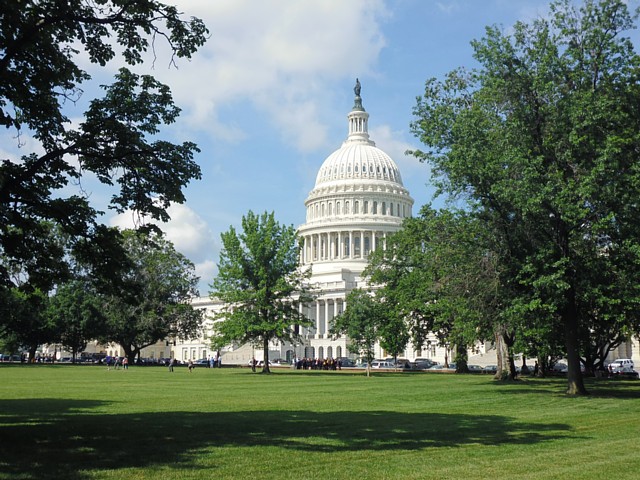2017年7月19日
著者:小野 康英(米国特許弁護士)

著者撮影
1789年に発効した米国憲法(The United States Constitution)は、いわゆる特許条項(Patent Clause)を有する(第1章第8条第8項)。
The United States Constitution, Article I, Section 8, Clause 8
The Congress shall have power ... [t]o promote the progress of science and useful arts, by securing for limited times to authors and inventors the exclusive right to their respective writings and discoveries[.]
米国議会は、この特許条項に基づき、1790年、米国初の特許法を制定した(Patent Act of 1790)。そして、1952年に制定された現行特許法(35 U.S.C.: United States Code Title 35 - Patents)に至るまで、米国特許法は、全て、この特許条項に基づき、米国議会が制定したものである。
一方、州政府は、特許法と抵触する法律を制定することができない。その法的根拠は、米国憲法の最高法規条項(Supremacy Clause)である(第6章)。
The United States Constitution, Article VI
[]This Constitution, and the laws of the United States which shall be made in pursuance thereof; and all treaties made, or which shall be made, under the authority of the United States, shall be the supreme law of the land; and the judges in every state shall be bound thereby, anything in the Constitution or laws of any State to the contrary notwithstanding.[]
実際、米国最高裁は、最高法規条項を根拠に、特許法と抵触するいくつかの州法を無効にしている。Sears, Roebuck & Co. v. Stiffel Co., 376 U.S. 225 (1964)(注1); Bonito Boats v. Thunder Craft Boats, 489 U.S. 141 (1989)(注2).
仮に、米国憲法に特許条項が存在しない場合どうなるか?その場合でも、米国議会は、州際通商条項(Interstate Commerce Clause)に基づき特許法を制定することができると考えられる(注3)。
The United States Constitution, Article I, Section 8, Clause 2
The Congress shall have power ... [t]o regulate commerce ... among the several states[.]
ただし、米国議会が州際通商条項に基づき特許法を制定する場合、州法との調整がより複雑になると考えられる。理由は、その場合、州政府は、修正第10条により、特許法の制定権限を有すると主張する可能性があるからである。
10th Amendment to the United States Constitution
The powers not delegated to the United States by the Constitution, nor prohibited by it to the states, are reserved to the states respectively, or to the people.
特許法が、連邦法及び複数の州法の形で並存することになったら、ルールの相違、権利取得手続の煩雑、費用の高騰、権利調整の複雑等により、米国における特許制度は、その実効性を著しく損なう可能性がある。
米国における特許法が、結果として、そのような制度にならなかったのは、米国建国時、連邦制度を推進した、ジェームス・マディソン(James Madison)他のフェデラリスト(連邦制度推進派)の功績が大きかったと考えられる(注4)。なお、ジェームス・マディソンが米国における特許制度の功労者であることは、米国特許商標庁(United States Patent and Trademark Office)の本部の建物が"The Madison Buildings"と命名されていることからも推察できる(注5)。
これに対し、1947年に施行された日本国憲法は、第 29 条に、財産権全般についての一般条項を有するにとどまる。
日本国憲法第 29 条
財産権は、これを侵してはならない。
財産権の内容は、公共の福祉に適合するように、法律でこれを定める。
私有財産は、正当な補償の下に、これを公共のために用いることができる。
日本では、日本国憲法における特許条項の欠如は、特許法の制定に影響が全くない(注6)。一方、米国憲法における特許条項の存在は、特許法の制定に大きな影響をもつ。この違いは、結局のところ、日本が中央集権国家であるのに対し、米国が連邦国家であるという違いに帰着すると考えられる。
日々の特許実務との関係で最も重要である、現行の米国特許法(35 U.S.C.)及び日本国特許法(昭和34年法律第121号)は、多くの共通点を有するが、同時に、上で述べた憲法上の根拠を含めて、多くの相違点を有する。日本国の特許出願書類に基づき米国の特許出願書類を作成するにあたっては、特に、特許取得及び特許行使に影響を及ぼす可能性のある制度上の相違点を適切に理解しておくことが重要である。
注釈
(注1)Sears, Roebuck & Co. v. Stiffel Co., 376 U.S. 225 (1964): Sears社がStiffel社のランプをほぼそのまま模倣したランプを販売した事案。本事件では、そのランプについての特許が無効とされた状況において、不正競争防止法(イリノイ州法)に基づき、Stiffel社がSears社に対して損害賠償請求できるかどうかが争点となった。米国最高裁は、"a State could not, consistently with the Supremacy Clause of the Constitution,[] extend the life of a patent beyond its expiration date or give a patent on an article which lacked the level of invention required for federal patents."との一般論を判示した上で、"To allow a State by use of its law of unfair competition to prevent the copying of an article which represents too slight an advance to be patented would be to permit the State to block off from the public something which federal law has said belongs to the public. The result would be that while federal law grants only 14 or 17 years' protection to genuine inventions[], States could allow perpetual protection to articles too lacking in novelty to merit any patent at all under federal constitutional standards. This would be too great an encroachment on the federal patent system to be tolerated."と述べて、この不正競争防止法(イリノイ州法)を無効とした。なお、米国憲法の違憲立法審査権が連邦裁判所に属することは、判例で確立している。Marbury v. Madison 5 U.S. (1 Cranch) 137 (1803).
(注2)Bonito Boats v. Thunder Craft Boats, 489 U.S. 141 (1989): Thunder Craft Boats社(テネシー州)がBonito Boats社(フロリダ州)の繊維ガラス製の船体(the Bonito 5VBR fiberglass hull)の成型を模倣し、この成型を使用して製造した船を販売した事案。Bonito 5VBRの販売開始から6年以上経過後、「他人の書面による許可なく、販売目的で、その他人が製作した船体又は船の一部の複製のために成型工程を用いる行為を不法行為」と規定するフロリダ州法が成立した("The statute makes "[i]t ... unlawful for any person to use the direct molding process to duplicate for the purpose of sale any manufactured vessel hull or component part of a vessel made by another without the written permission of that other person."")。本事件では、このフロリダ州法に基づき、Bonito Boats社がThunder Craft Boats社に対して損害賠償請求できるかどうかが争点となった。米国最高裁は、"[w]e believe that the Florida statute at issue in this case so substantially impedes the public use of the otherwise unprotected design and utilitarian ideas embodied in unpatented boat hulls as to run afoul of the teaching of our decisions in Sears and Compco."と述べて、このフロリダ州法を無効とした。
(注3)州際通商条項(Interstate Commerce Clause)を根拠とする知的財産分野における連邦法上の立法としては、商標法及び営業秘密保護法が知られている。これらの法域では、連邦法及び州法が並存している。The Lanham (Trademark) Act (Pub.L. 79–489, 60 Stat. 427, enacted July 5, 1946, codified at 15 U.S.C. § 1051 et seq. (15 U.S.C. ch. 22)); The Defend Trade Secrets Act of 2016 (DTSA) (Pub.L. 114–153, 130 Stat. 376, enacted May 11, 2016, codified at 18 U.S.C. § 1836, et seq.).
(注4)Sears, Roebuck & Co. v. Stiffel Co., 376 U.S. 225, 228 (1964) ("Before the Constitution was adopted, some States had granted patents either by special act or by general statute,[] but when the Constitution was adopted provision for a federal patent law was made one of the enumerated powers of Congress because, as Madison put it in The Federalist No. 43, the States ‘cannot separately make effectual provision’ for either patents or copyrights.").
(注5)Remarks by Michelle K. Lee, then Under Secretary of Commerce for Intellectual Property and Director of the United States Patent and Trademark Office (USPTO), at 225th Anniversary of The First Patent Act at Madison Auditorium of the Madison Buildings on April 10, 2015 ("225 years ago today, the first Patent Act was signed into law by a famous resident of this area: President George Washington. Only one year had passed since this nation’s Constitution went into effect and the first Congress began its work, not just on the Patent Act, but also on the Copyright Act, also signed into law in 1790. A key author of that Constitution, and in particular the clause that gave us patents and copyrights, was another Virginian, whose name adorns this building. That, of course, was James Madison.").
(注6)この点、財産権一般の保護とは別に、知的財産権の保護を憲法上明記すべき旨の意見が存在する。たとえば、「憲法提言」(民主党憲法調査会、平成17 年10 月31 日);「日本国憲法改正草案」(自由民主党、平成24 年4 月27 日)参照。ただし、このいわゆる知的財産権保護条項は、これがなくても、特許法を含む知的財産法の制定に全く支障がない点で、米国憲法における特許条項とは、その法的性質が全く異なる。
Next>>第2回:米国特許法の基本~米国特許法の法源~
